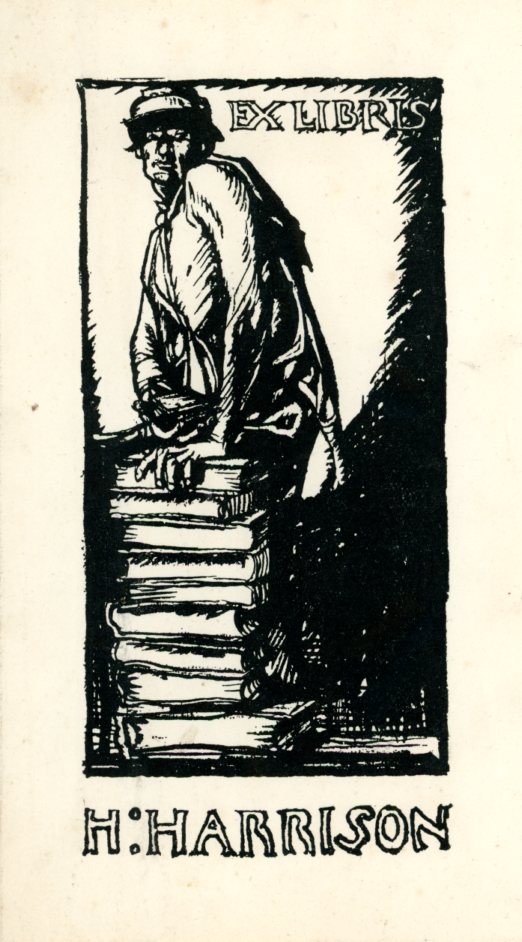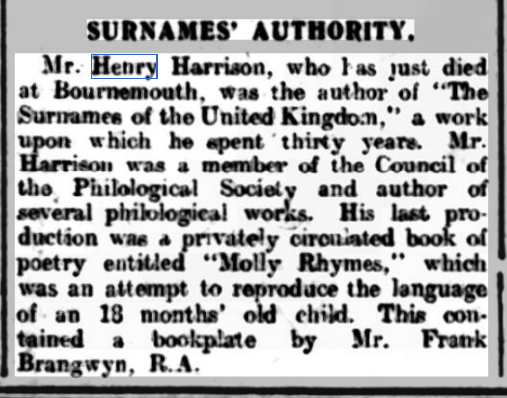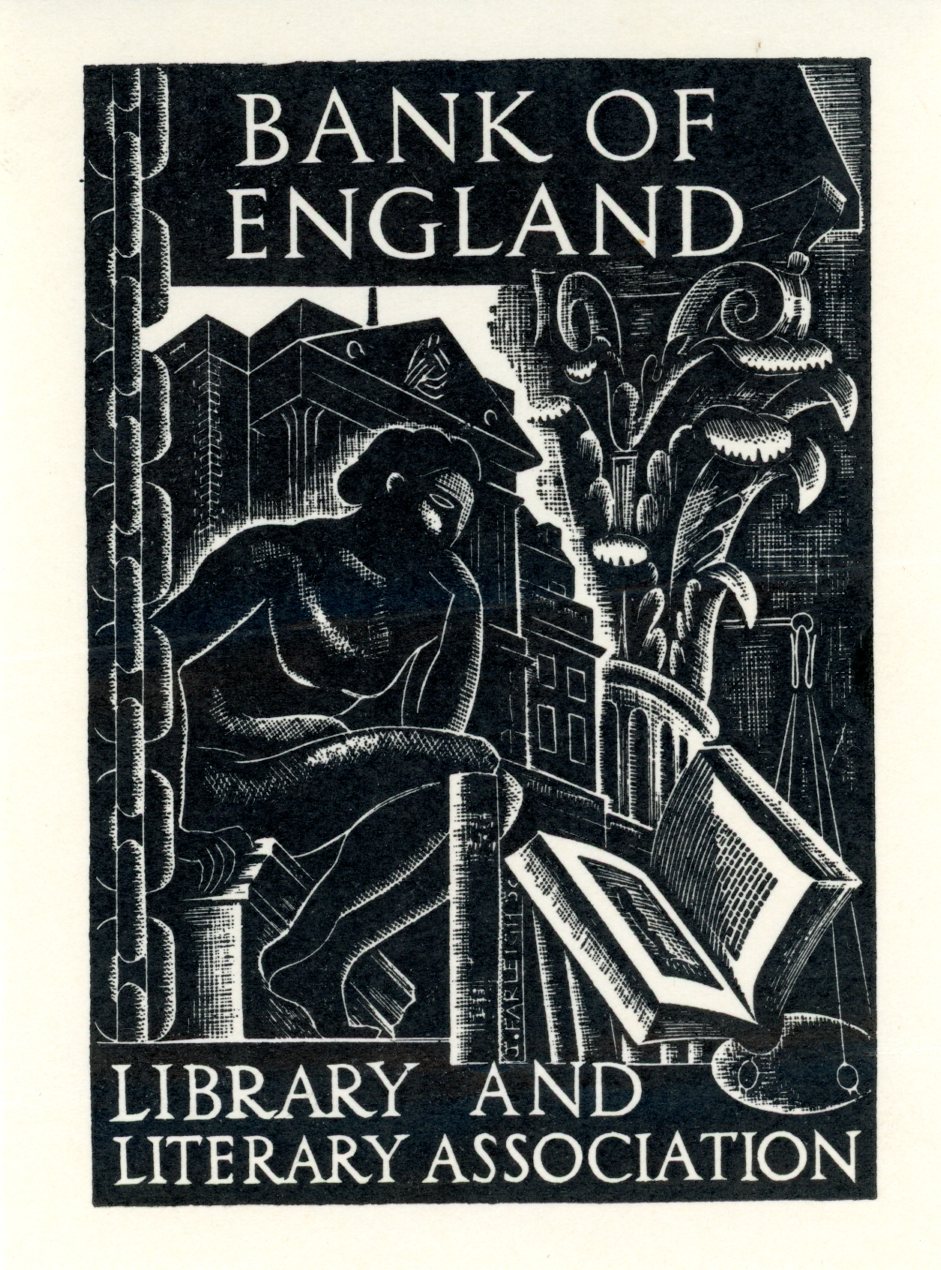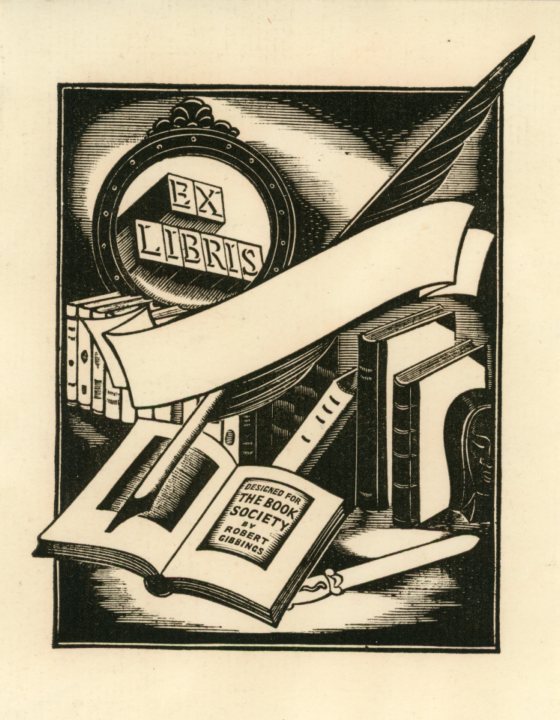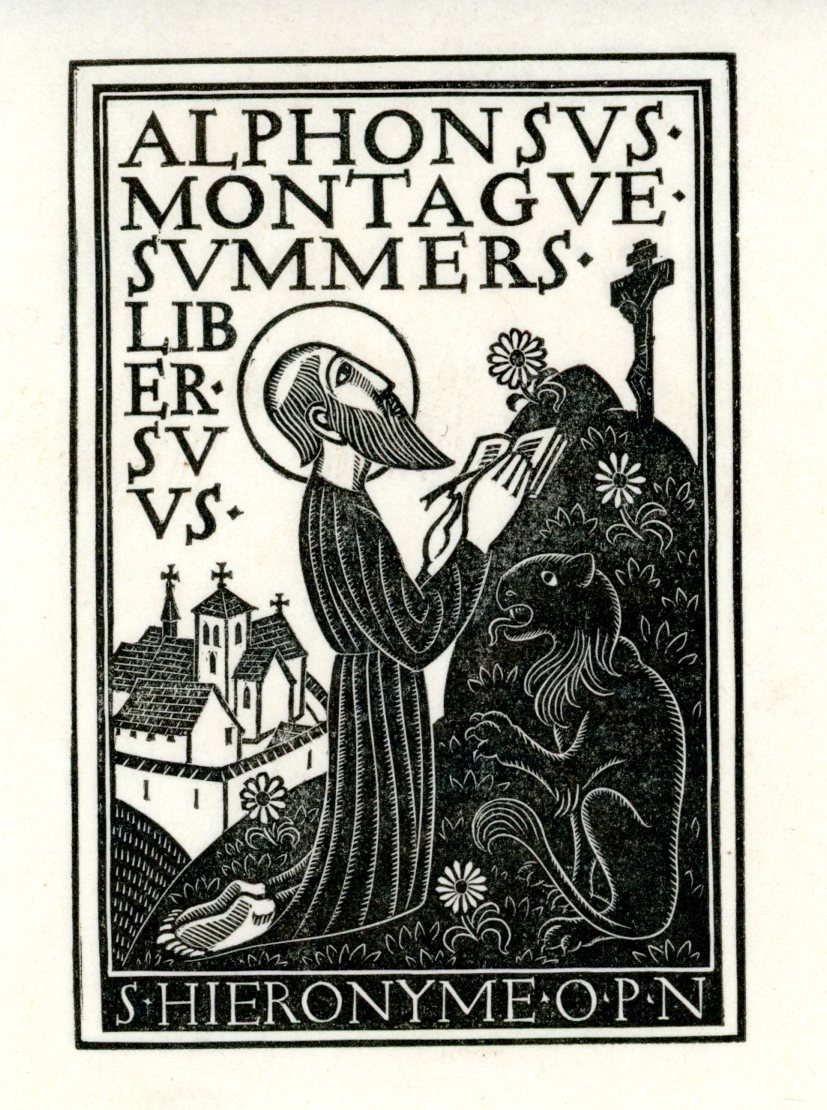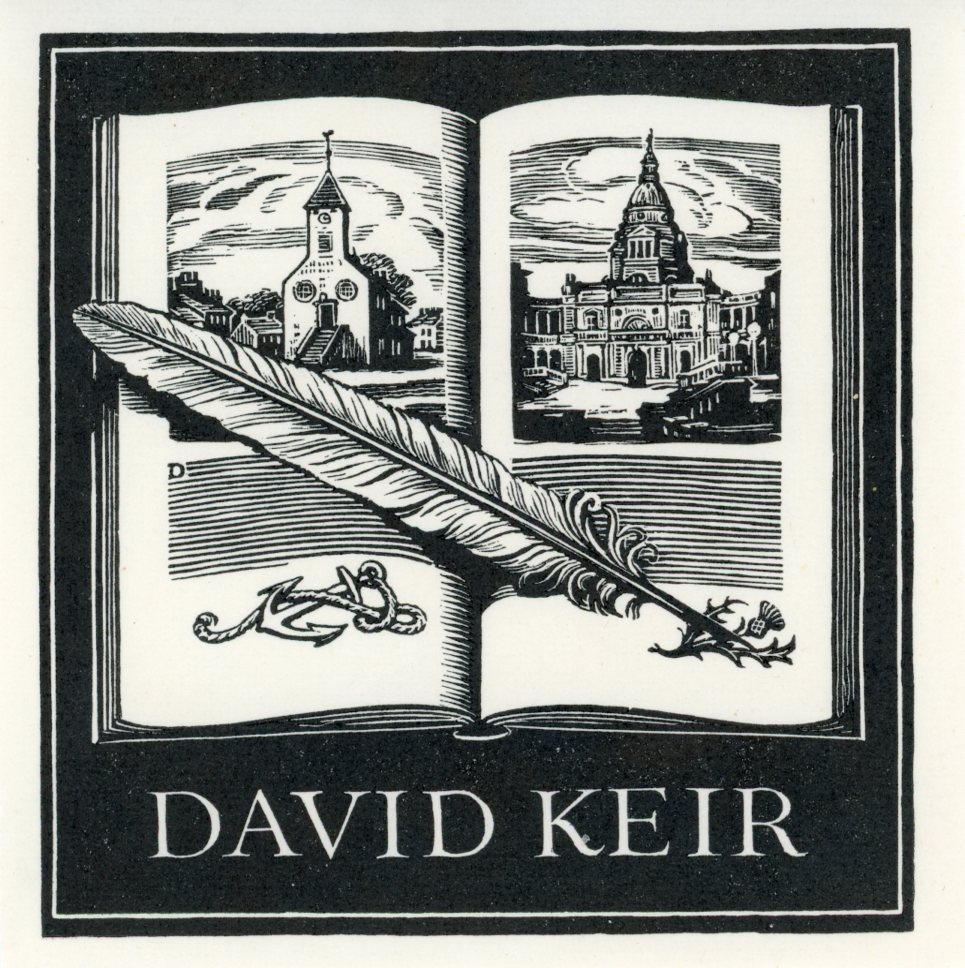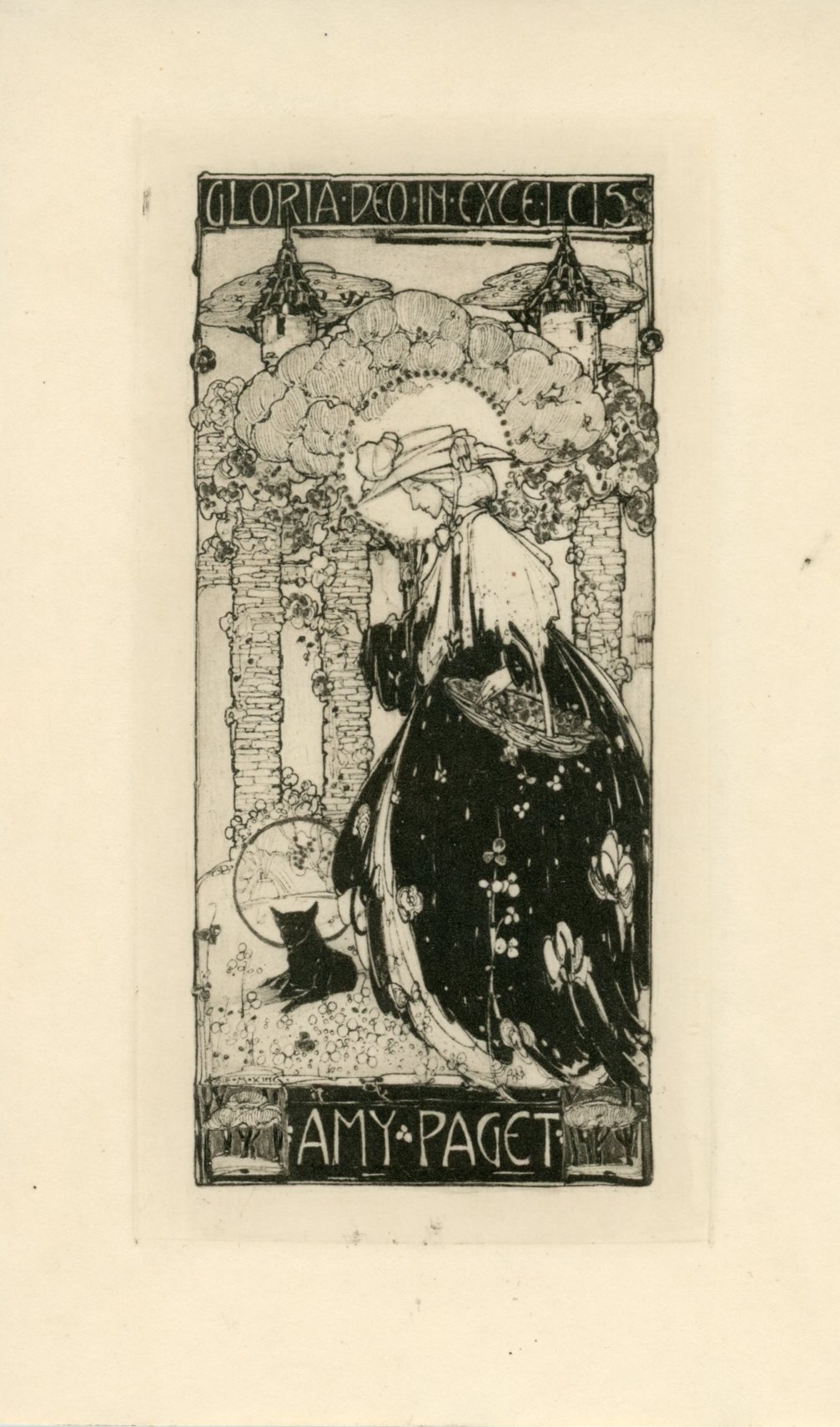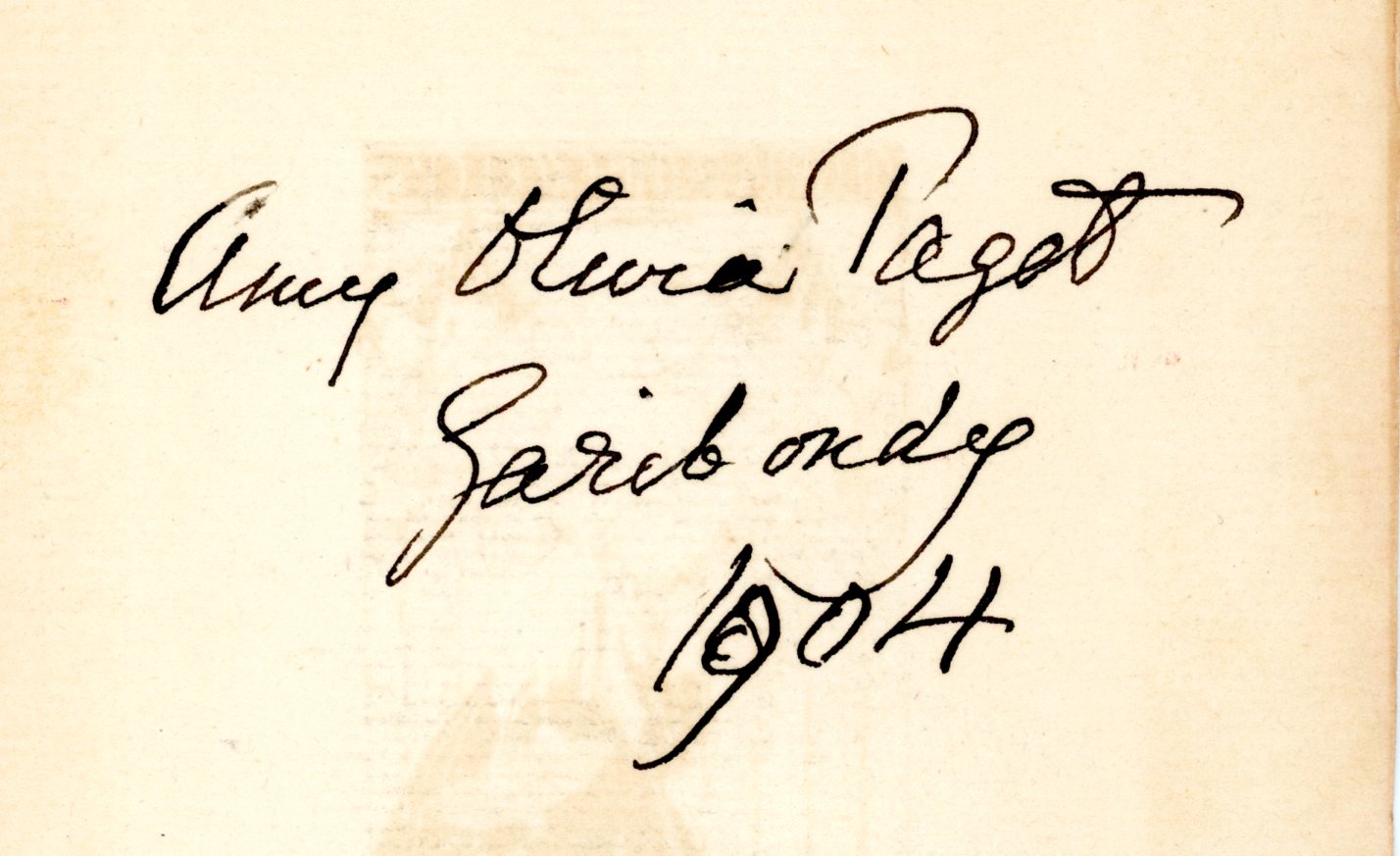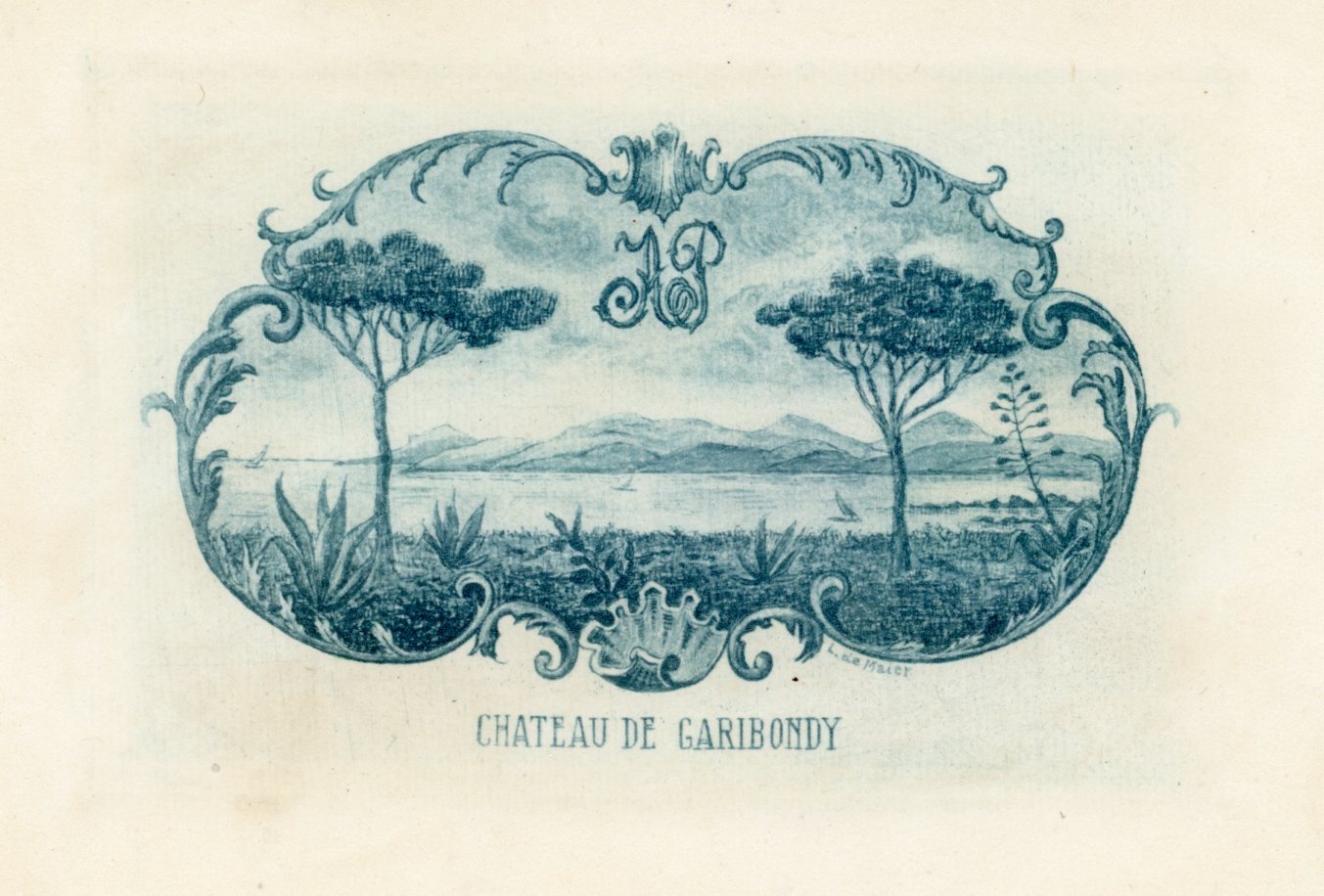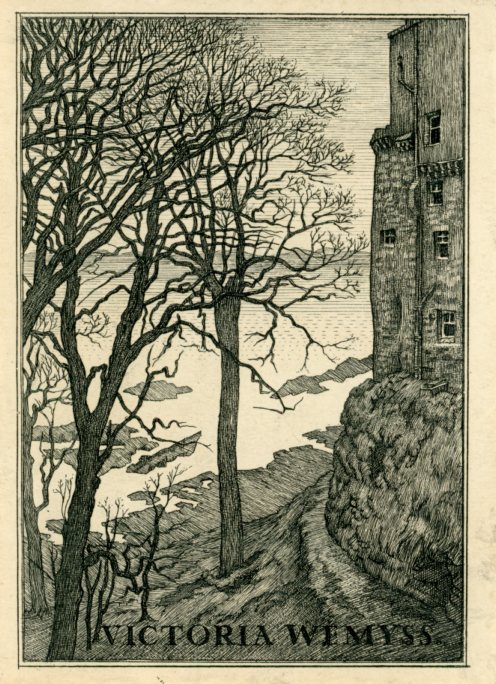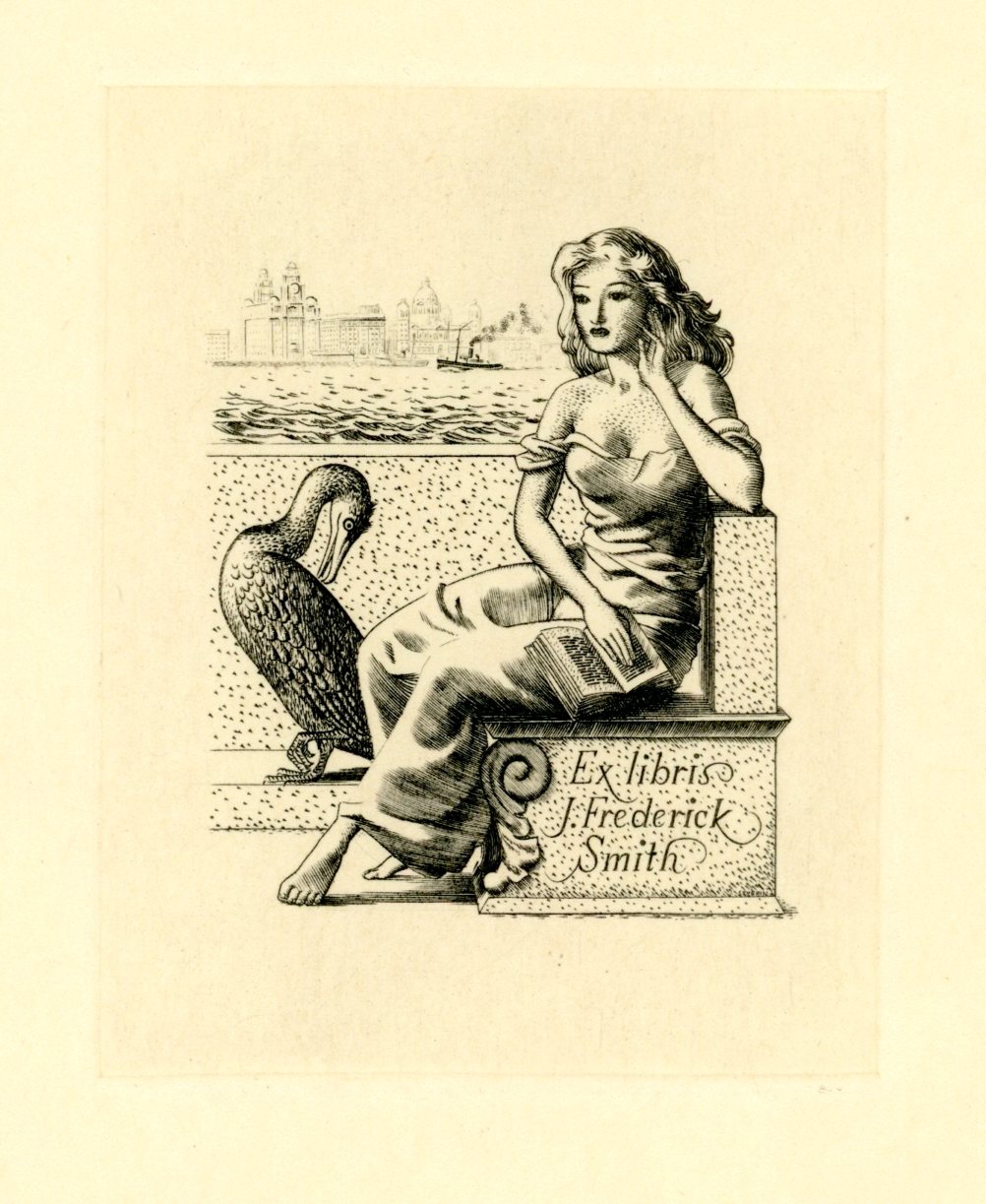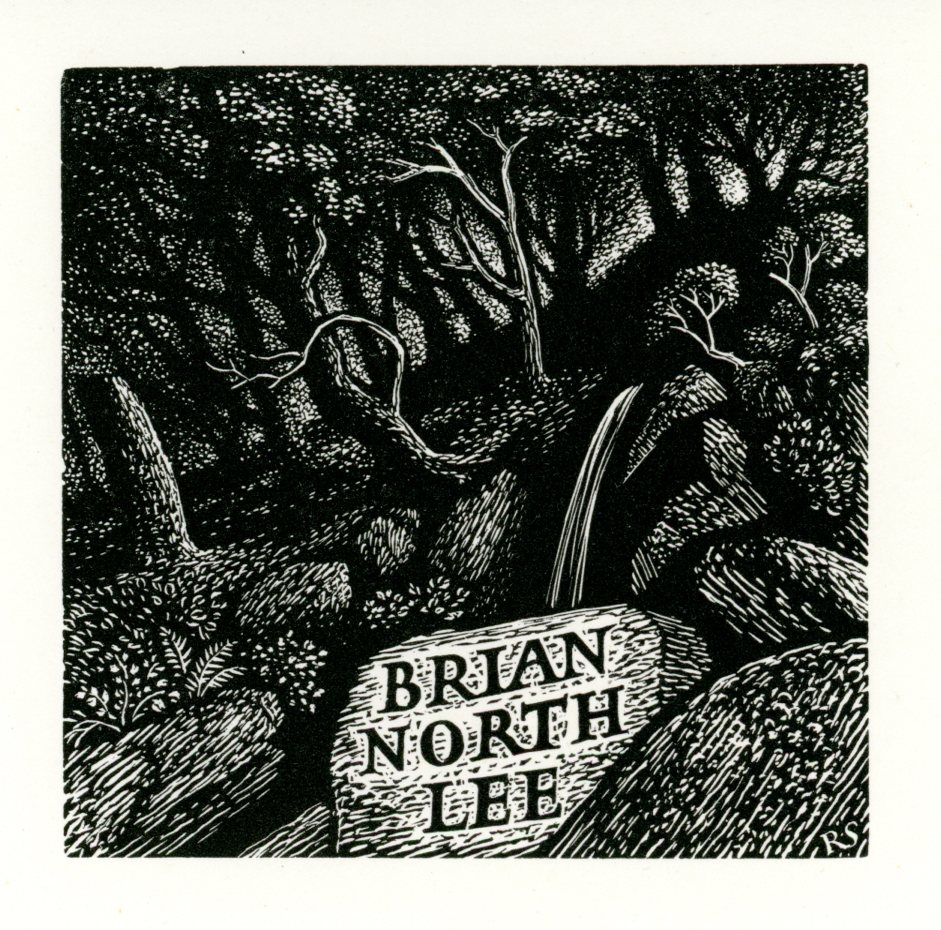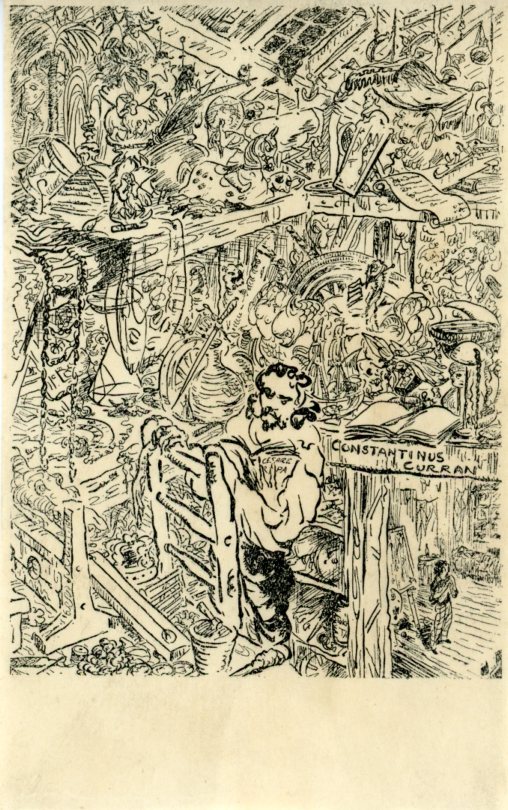Home >> Bookplates >>
Bookplates designed by artists
These bookplates were designed by an artist for a client or friend, and often engraved by the artist too, either on copper or wood. The only bookplate design by Mervyn Peake was probably not engraved by him, he just provided the drawing as part payment of a medical bill to his doctor who then had it made into a block for off-set printing on gummed paper.
You can click on each image to enlarge them a little then lick on the back button of your browser to return to the page.
The artists are:
- Frank Brangwyn
- William Evelyn Chappel
- John Farleigh
- Robert Gibbings
- Eric Gill
- Philip Hagreen
- Joan Hassall
- Margaret Kemp-Welch
- Jessie M. King and Louis de Maier
- William Evan Charles Morgan
- Mervyn Peake
- Henry Rushbury
- Mark Severin
- Reynolds Stone
- Joseph Walter West
- Rex Whistler
- Jack B. Yates
Added on 11/8/2023: Bookplate designed by Robert Gibbings.
Added on 29/9/2023: Bookplate designed by Frank Brangwyn.
Added on 9/9/2024: Bookplates designed by Joan Hassall and Joseph Walter West were added, and the page was revised with plates put in alphabetical order of the artist and given links from the top.
Artist: Frank Brangwyn
For: H. Harrison
Date: c1920
Paper size: 160 x 91 mm
Plate size: none
Design size: 132 x 63 mm
Notes: This bookplate was designed by Frank Brangwyn for Henry Cowperthwaite Harrison, the author of Surnames of the United Kingdom: a concise etymological dictionary published between 1912 and 1920 by the Eaton Press and Morland Press.
Harrison seems to have been a self-made man. In the 1891 census he was listed as a Merchant's Clerk aged 24 living in London with his wife Catherine Angus Harrison née Miller, who was 10 years older than him. They had daughters in 1891 and 1894 - Constance Kathleen and Margaret Mary - neither of whom married.
In the 1901 census the Harrisons were living in Wandsworth with Henry listed as a Private Journalist, presumably writing for publication. His wife died aged 51 in 1908 and he married again in 1910, aged 43, to Gytha Marjory Lettice Pulling, who was 24. They had a son in 1911 named Eric Athelstan Pulleyne Harrison.
In the 1911 census Harrison was listed as Author Journalist, presumably working on his Dictionary of Surnames, which is said to have taken him 30 years to write. It was published in many parts over the next 10 years. His wife, Gytha, was credited too, but she died aged 31 in 1917.
In September 1917 Henry, aged 50, married for a third time, 25-year old Emily Winstanley Ford, with whom he had a daughter in July 1918, Mildred Winstanley Harrison, named ‘Mollie’.
This bookplate was issued inside a 24-page privately printed book entitled Mollie Rhymes containing verses presumably written by her father and published from their house in Longfield, Kent. The edition was printed in March 1920, limited to 125 copies.
Henry Harrison died in Bournemouth the following year, on 25th February 1921 aged 54, of pneumonia. He had been married to his third wife for just 3½ years. She lived for another 66 years, before dying in 1987 in a nursing home in East Grinstead, aged 95. Harrison's daughter Constance had died in 1952 aged 61; Margaret had died in 1980 aged 86; son Eric had died in 1963 aged 52, and Mollie, who inspired this book of rhymes and the use of the bookplate, had died in September 1947 aged only 29.
Artist: William Evelyn Chappel
For: June Moore
Date: 1926
Paper size: 187 x 125 mm
Design size: 150 x 113 mm
Engraver: Not known
Notes: This interesting bookplate from the mid-1920s was designed for June Moore (1898-1964), born June Langley, who in 1918 married a man named John Sugden Moore and took the name June Langley Moore. June's younger sister, Doris (1902-1989), married John's brother Robert, and took the name Doris Langley Moore. Doris was a historian of fashion and founded the Fashion Museum in Bath. She also wrote books about Lord Byron and a biography of E. Nesbit. In 1933 Doris and June published a guide for society hostesses called The Pleasure of Your Company (1933). This book (and the bookplate) were illustrated by William Chappel (1907-1994) who was a ballet dancer, designer and director. It must have been fun to be in your 20s in the 1920s.
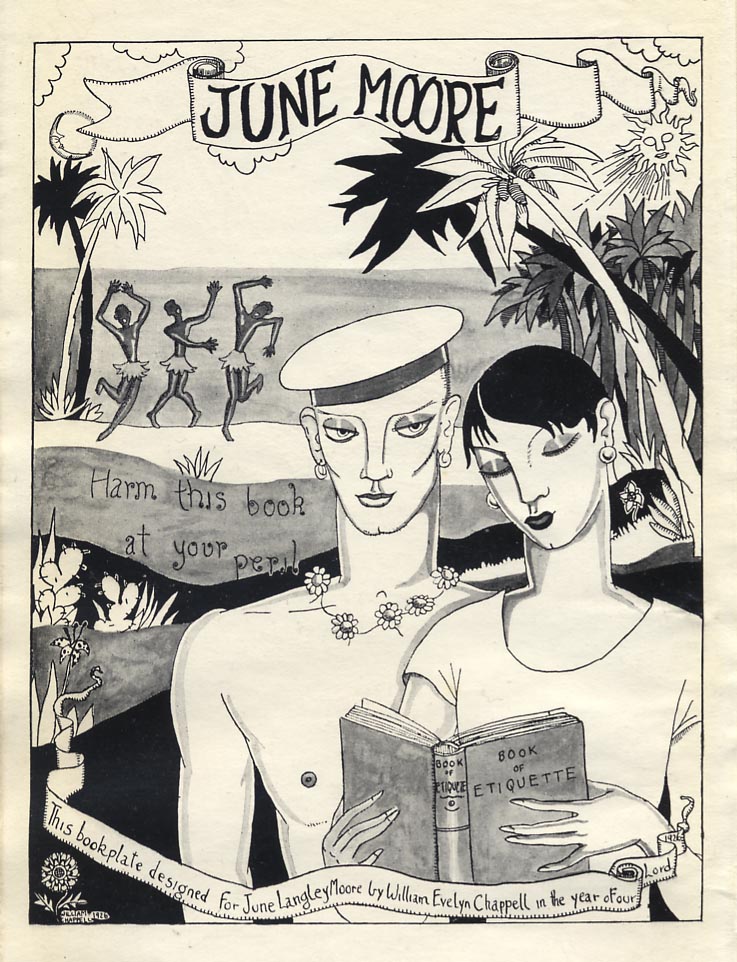
Artist: John Farleigh
For: Bank of England Library and Literary Association
Date: 1950s?
Paper size: 110 x 181 mm
Plate size: none
Design size: 96 x 66 mm
Notes: This bookplate was designed and engraved on wood by John Farleigh (1900-1965), probably in the 1950s for The Library and Literary Association of the Bank of England. This group published 346 issues of a magazine called The Old Lady from March 1921 to December 2007. It was founded by a group of literary-minded Bank staff.
Artist: Robert Gibbings
For: The Book Society
Date: c1930
Paper size: 125 x 98 mm
Plate size: none
Design size: 105 x 80 mm
Notes: This is an example of a universal design for a bookplate for use by members of the Book Society who could write their own name in the scroll under 'Ex libris'. It is probably a wood engraving by Robert Gibbings (1889-1958), an Irish artist and writer.
Artist: Eric Gill
For: Francis Meynell
Date: 1914
Paper size: 112 x 92 mm
Design size: 80 x 64 mm
Engraver: Eric Gill
Notes: It is a wood engraving. Francis Meynell (1891-1975) was a poet and printer. The bookplate was designed for him by Eric Gill an artist and designer of type faces. The proof in the British Museum is dated 1914.
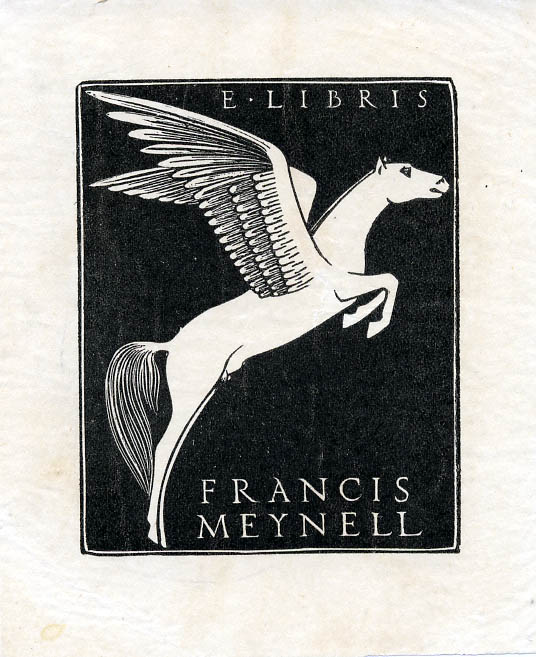
Artist: Philip Hagreen
For: Alphonsus Montague Summers
Date: 1930s?
Paper size: 96 x 75 mm
Plate size: none
Design size: 83 x 56 mm
Notes: This bookplate was designed and engraved on wood by Philip Hagreen (1890-1988) for Augustus Montague Summers (1880-1948), a self-styled Catholic priest who called himself Reverend Alphonsus Joseph-Mary Augustus Montague Summers. Summers taught Latin and English in boys' schools and was a literary schoolar who was said to be preoccupied with Catholicism, Satantism and pederasty. He was prosecuted for sexual impropriety with young boys, tried, and acquited. These days he would probably not have been allowed to teach children.
Philiph Hagreen was also religious and in 1932 moved to Ditchling in East Sussex where he joined the The Guild of St Joseph and St Dominic, a community of people working in art and crafts. He lived to be 98.
Artist: Joan Hassall
For: David Keir
Date: 1960s?
Paper size: 84 x 83 mm
Plate size: none
Design size: 74 x 76 mm
Notes: This bookplate was designed and engraved on wood by Joan Hassall (1906-1988) for David Keir (1895-1975), an Historian.
Artist: Margaret Kemp-Welch
For: Ida Emily Southerden
Date: c1925
Paper size: 135 x 102 mm
Plate size: 114 x 84
Design size: 114 x 84 mm
Notes: This etched bookplate was designed for Ida Emily Southerden (1870-1946), who taught Science at Clapham High School for girls, presumably where she met the artist Margaret Kemp-Welch (1874-1968), who also taught there.
I found proofs in the three volumes of Trees and Shrubs Hardy in the British Isles by W.J. Bean published by John Murray, fifth edition, April 1929.
Artist: Jessie M. King
For: Amy Paget
Date: c1904
Paper size: 146 x 88 mm
Plate size: 114 x 58
Design size: 102 x 48 mm
Notes: This was designed for Amy Olivia Paget (1858-1948), one of 14 children of Lord Alfred Henry Paget (1816-1888) and his wife, Cecelia née Wyndham (1829-1914). Amy lived for most of her life, including both World Wars, at Château de Garibondy, situated on a hill overlooking Cannes in the south of France.
The plate was designed by Jessie M[arion] King (1875-1949) who was best known for her illustrated children's books. She is said to have been an influence on the development of Art Deco. She believed in fairies.
The Latin phrase 'Gloria deo in excelsis' means 'Glory to god in the highest'. The two turrets at the top of the image are based on Château de Garibondy which also has a large fir tree in front of it, which is still there according to current photographs.
I found proofs of this plate in the two volumes of The Queen's Comrade. The Life and Times of Sarah Duchess of Marlborough by Fitzgerald Molloy (Hutchinson, 1901).
Artist: Louis de Maier
For: AP, Chateau de Garibondy
Date: unknown
Paper size: 110 x 152 mm
Plate size: 62 x 98
Design size: 54 x 90 mm
Notes: This is another bookplate designed for Amy Paget for her house, Château de Garibondy. The scene probably shows the view from the house over the bay of Cannes, flanked by fir trees with sisal plants in the foreground. There is a plate mark but it doesn't look like an engraving or etching, more like a poorly reproduced watercolour.
I can't find out anything about Louis de Maier except there is a folio of 15 bookplates designed by him, mostly armorial, published in 1923.
Artist: William Evan Charles Morgan
For: Victoria Wemyss
Date: 1930s
Paper size: 117 x 85 mm
Plate size: not known
Design size: 101 x 77 mm
Notes: This bookplate was designed and engraved by William E.C. Morgan in the late 1930s for Lady Victoria Alexandrina Violet Erskine-Wemyss née Cavendish-Bentinck, who was a god child of Queen Victoria. She was the only daughter of the sixth Duke of Portland and was brought up as a vegetarian. During the First World War she worked in an aircraft factory in London where she was unknown until the King visited the factory, he spotted her in the crowd, and greeted her by name. In November 1918 she married Captain Michael John Erskine Wemyss. They lived at Wemysss Castle in Fife, Scotland, which is depicted in the engraving. She died in 1994 aged 104.
This is one of only five known bookplates by William E.C. Morgan (1903-1979), an exceptionally fine engraver.
Artist: Mervyn Peake
For: N. Asherson
Date: 1937
Paper size: 101 x 96 mm
Design size: 86 x 84
Engraver: Not known
Signed: Mervyn Peake
Notes: This bookplate was designed by Mervyn Peake (1911-1968) for Dr Nehemiah Asherson, an Ear, Nose and Throat specialist. Asherson had treated the Peake family and the drawing was provided in part payment. The design shows the three bones in the middle ear, the malleus, incus and stapes, or hammer, anvil and stirrup.
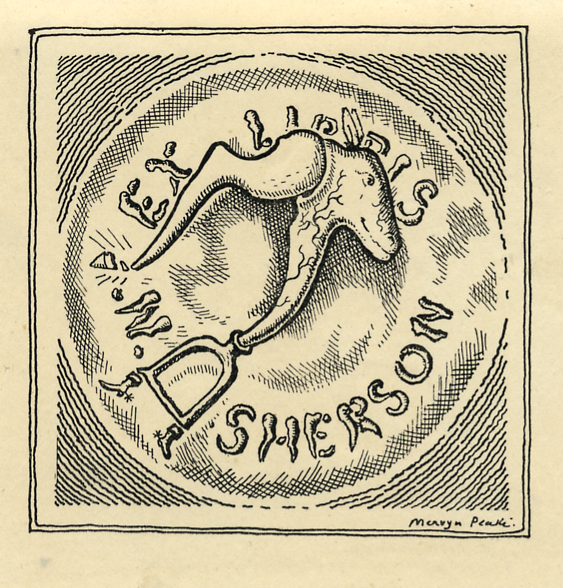
Artist: Henry Rushbury
For: D.R.H. Williams
Date: 1924
Paper size: 159 x 97 mm
Design size: 131 x 72 mm
Engraver: Henry Rushbury
Notes: This is one of only three bookplates designed by Sir Henry Rushbury (1889-1968), according to his catalogue raisonné. It is stained as someone taped the edge of the dustjacket over the bookplate, which was on the front pastedown.
No 49 in: Henry Rushbury Prints. A catalogue raisonné. (2010). London: The Royal Academy of Arts.
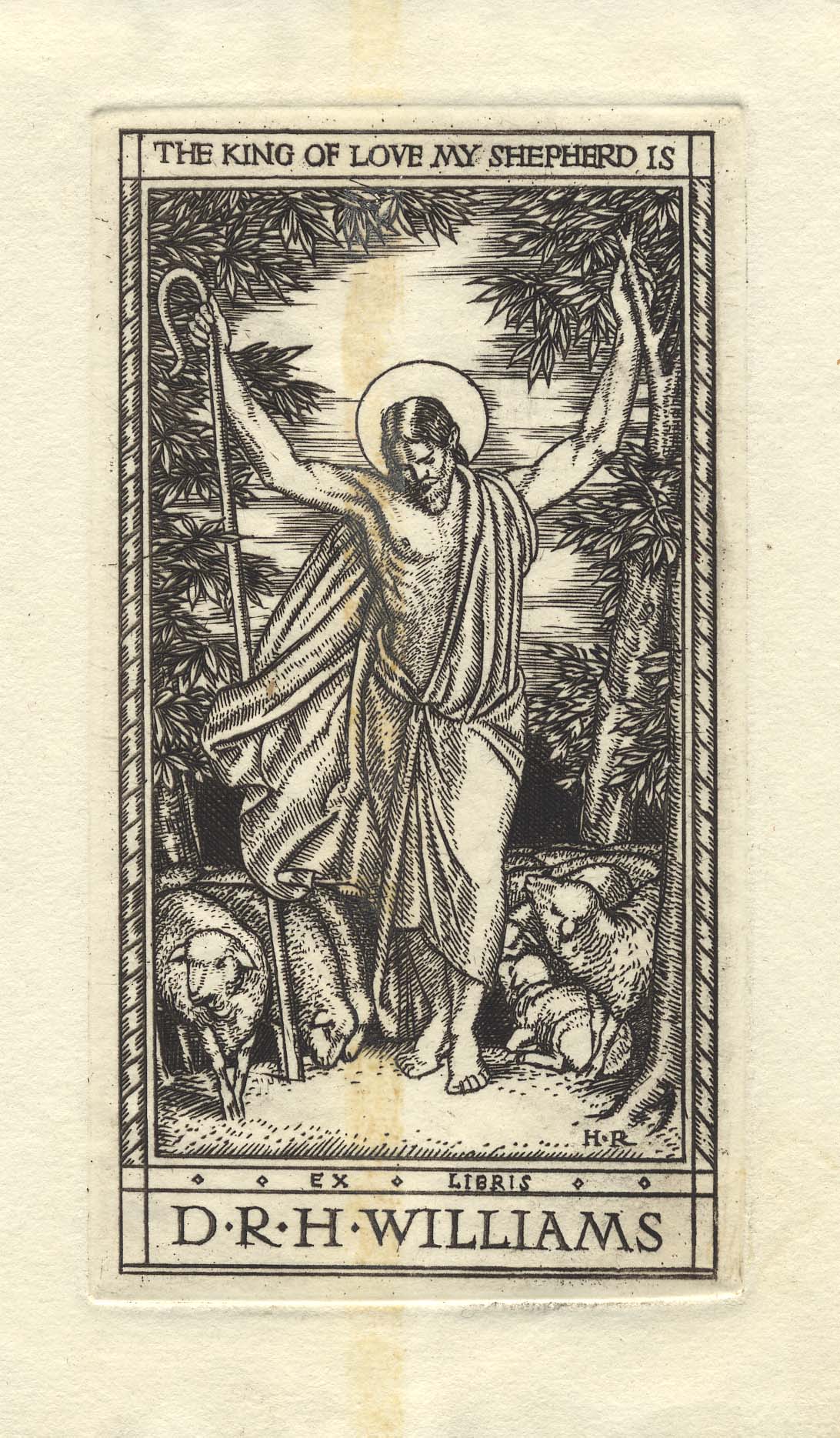
Artist: Mark Severin
For: J. Frederick Smith
Date: 1950s?
Paper size: 139 x 119 mm
Plate size: 85 x 67
Design size: 59 x 49 mm
Designer: Mark Severin
Engraver: Mark Severin
Notes: This bookplate was designed and engraved by Mark Severin, probably in the 1950s for J. Frederick Smith, who was Chief Librarian at Liverpool Public Library. The Liver Building and a Liver bird (A Cormorant) are depicted in the plate with a woman wearing a low-cut dress. Severin designed about 500 bookplates, many of which were erotic in their subject matter, some of which were anatomical in their detail of female genitalia. I can't imagine lending a book with such a bookplate, so perhaps they were commissioned by men who collected erotica? This bookplate is quite modest in comparison.
Artist: Reynolds Stone
For: Brian North Lee
Date: 1970s?
Paper size: 81 x 84 mm
Plate size: none
Design size: 66 x 68 mm
Notes: This bookplate was designed and engraved on wood by Reynolds Stone (1909-1979), probably in the 1970s for Brain North Lee, a prolific writer on the subject of bookplates who had many designed for him.
Artist: Joseph Walter West
For: Henry Edward Verey
Date: 1905
Paper size: 114 x 79 mm
Design size: 95 x 70 mm
Engraver: Joseph Walter West
Notes: This bookplate was designed by Joseph Walter West (1860-1933), an artist in watercolours who designed posters for the London Underground. T He was Vice-President of the Royal Watercolour Society (RWS) for two years between 1918 and 1920.
The design is signed by his monogram: a weathervane pointing west with the letters of his name and the initials R.W.S. underneath.
Lieutenant Colonel Henry Edward Verey, D.S.O. (1887-1968) fought in World War I and was injured. After the war he practiced as a solicitor.
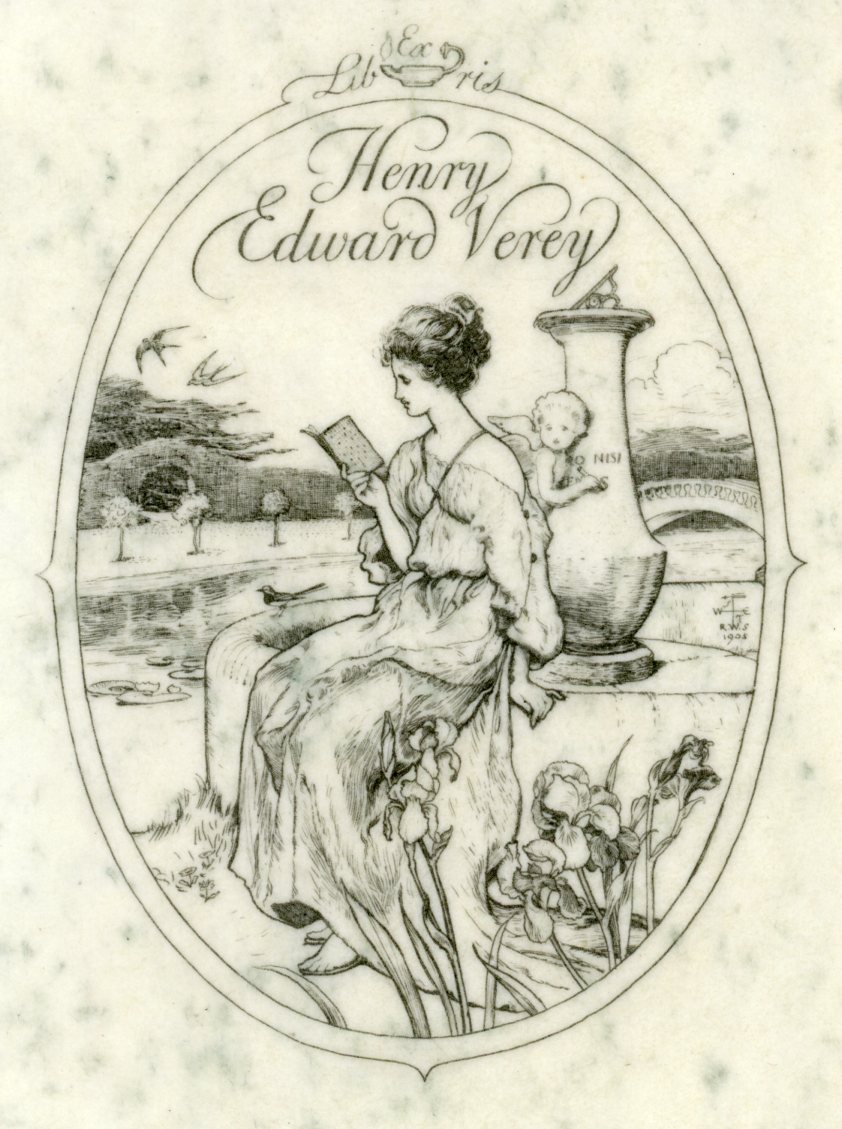
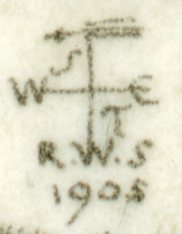
The monogram of Joseph Walter West
Artist: Rex Whistler
For: Duff Cooper
Date: 1930s
Paper size: 115 x 85 mm
Design size: 97 x 69 mm
Engraver: Rex Whistler
Notes: Duff Cooper (1890-1954) was a Conservative politician, diplomat and historian. In 1919 he married Diana Manners a famously glamorous woman. She is depicted at the top of this bookplate, designed by Rex Whistler (1905-1944), who died during the invasion of Normandy in World War II, aged 39. He painted the murals in the restaurant of the Tate Gallery at Millbank in London when he was only 22. The murals have been identified as racist and the restaurant has closed. The room may be reopened as a gallery with an explanation of why Whistler's murals are no longer acceptable.
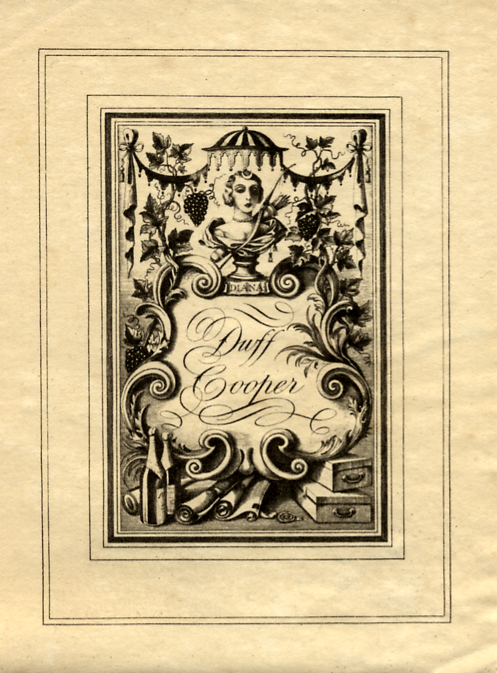
Artist: Rex Whistler
For: Kenneth Rae
Date: 1931
Paper size: 109 x 79 mm
Plate size: 95 x 68 mm
Design size: 86 x 63 mm
Engraver: Not known
Notes: Kenneth Rae (1890-1954) was Editor of the Sunday Times and Secretary to the Board of the National Theatre. Rex Whistler (1905-1944) designed this bookplate for him to thank him for lending some skiing equipment. The proof in the Victoria and Albert Museum states that it is a soft ground etching.
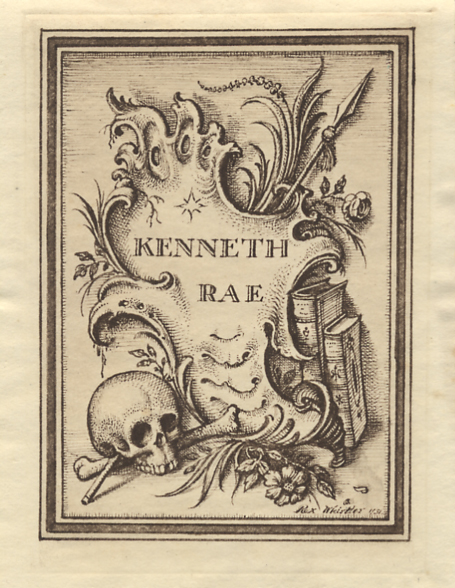
Artist: Jack B. Yeats
For: Constantinus Curran
Date: c1940
Paper size: 139 x 86 mm
Plate size: not known
Design size: 113 x 83 mm
Notes: This was designed for Constantine Peter Curran (1883-1972) by Jack Butler Yeats (1871-1957). Curran was a Court Registrar in Ireland and a critic of art and architecture who wrote a monograph on the work of Jack B. Yeats. The bookplate is reproduced on the cover of a booklet called Revolutionary Dublin's Literary Networks: C.P. Curran, Helen Laird and James Joyce's Ulysses, to accompany an exhibition in the University College Dublin Special Collections Reading Room, which can be seen here.
I found proofs of this bookplate in a very badly damaged copy of A Century of painters of the English School by Richard Redgrave R.A. and Samuel Redgrave, published by Smith, Elder and Co, in 1866. The book was recycled but the bookplate survives. I wonder how many interesting bookplates have been recycled with unwanted books?
